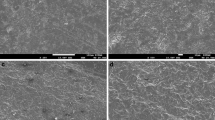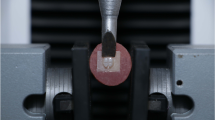Abstract
Purpose
This study evaluated the shear bond strength (SBS) of a metal bracket bonded to three different computer-aided design/computer-aided manufacturing (CAD/CAM) restoration materials pretreated with different surface treatments. In addition, the surface topography and color change of the restorations after debonding with two different tungsten carbide burs were examined.
Methods
A total of 216 plates were cut from three different CAD/CAM blocks, each of which was divided into three subgroups with different pretreatment methods: (1) acid etching, (2) sandblasting, and (3) laser irradiation. Incisor metal brackets were bonded. The SBS test was performed, and the failure types were classified. Then, samples were randomly divided into two subgroups according to the adhesive removal procedure to be used: a tungsten carbide bur with 12 blades or 24 blades (n = 12). Color change was calculated based on the ∆E00, and surface morphology was evaluated via SEM and AFM analysis.
Results
The SBS data revealed that the type of CAD/CAM material and the applied surface treatment significantly affected bond strength. The highest SBS values were detected for the Grandio Blocs (VOCO GmbH, Cuxhaven, Germany; 14.3 ± 4.4 MPa), and the lowest was observed for Cerasmart (GC Europe, Leuven, Belgium; 12.0 ± 4.0 MPa). The ∆E00 results demonstrated significant differences only as a result of the applied surface treatment. The ∆E00 value in all groups was above the 1.77 threshold.
Conclusion
CAD/CAM material types and surface treatments affected the bond strength, but the interactions of these factors did not. The chosen surface treatment also significantly affected the ∆E00 after the polishing was done.
Zusammenfassung
Zielsetzung
In dieser Studie wurde die Scherhaftfestigkeit (SBS) eines Metallbrackets bewertet, das mit 3 unterschiedlichen CAD/CAM(„computer-aided design/computer-aided manufacturing“)-Restaurationsmaterialien verbunden ist, die mit verschiedenen Oberflächenbehandlungen vorbehandelt wurden. Darüber hinaus wurden die Oberflächentopografie und die Farbveränderung der Restaurationen nach dem Debonding mit 2 verschiedenen Hartmetallfräsern untersucht.
Methoden
Aus drei verschiedenen CAD/CAM-Blöcken wurden insgesamt 216 Platten geschnitten, die jeweils in drei Untergruppen mit unterschiedlichen Vorbehandlungsmethoden unterteilt wurden: (1) Säureätzung, (2) Sandstrahlung und (3) Laserbestrahlung. Auf die Schneidezähne wurden Metallbrackets geklebt. Der SBS-Test wurde durchgeführt und die Versagensarten wurden klassifiziert. Dann wurden die Proben nach dem Zufallsprinzip in zwei Untergruppen aufgeteilt, je nachdem, welches Verfahren zur Entfernung des Klebers verwendet wurde: ein Hartmetallbohrer mit 12 Klingen oder 24 Klingen (n = 12). Die Farbveränderung wurde auf der Grundlage des ∆E00 berechnet, und die Oberflächenmorphologie wurde mittels REM- und AFM-Analyse bewertet.
Ergebnisse
Die SBS-Daten zeigten, dass die Art des CAD/CAM-Materials und die angewandte Oberflächenbehandlung die Haftfestigkeit erheblich beeinflusste. Die höchsten SBS-Werte wurden für die Grandio Blocs (VOCO GmbH, Cuxhaven, Deutschland; 14.3 ± 4.4 MPa) ermittelt, die niedrigsten für Cerasmart (GC Europe, Leuven, Belgien; 12.0 ± 4.0 MPa). Die ∆E00-Ergebnisse zeigten signifikante Unterschiede nur in Bezug auf die Oberflächenbehandlung. Der ∆E00-Wert lag in allen Gruppen über dem Schwellenwert von 1,77.
Schlussfolgerung
CAD/CAM-Materialtypen und Oberflächenbehandlungen beeinflussten die Haftfestigkeit, nicht aber die Wechselwirkungen dieser Faktoren. Die gewählte Oberflächenbehandlung wirkte sich auch signifikant auf den ∆E00-Wert nach der Polierung aus.






Similar content being viewed by others
References
Kurt İ, Çehreli ZC, Özçırpıcı AA, Şar Ç (2019) Biomechanical evaluation between orthodontic attachment and three different materials after various surface treatments: a three-dimensional optical profilometry analysis. Angle Orthod 89:742–750. https://doi.org/10.2319/072918-547.1
Elsaka SE (2016) Influence of surface treatments on bond strength of metal and ceramic brackets to a novel CAD/CAM hybrid ceramic material. Odontology 104:68–76. https://doi.org/10.1007/s10266-014-0188-8
Spitznagel FA, Boldt J, Gierthmuehlen PC (2018) CAD/CAM ceramic restorative materials for natural teeth. J Dent Res 97:1082–1091. https://doi.org/10.1177/0022034518779759
Coldea A, Swain MV, Thiel N (2013) Mechanical properties of polymer-infiltrated-ceramic-network materials. Dent Mater 29:419–426. https://doi.org/10.1016/j.dental.2013.01.002
Ghozy EA, Shamaa MS, El-Bialy AA (2020) In vitro testing of shear bond strength of orthodontic brackets bonded to different novel CAD/CAM ceramics. J Dent Res Dent Clin Dent Prospects 14:239–243. https://doi.org/10.34172/joddd.2020.042
Gunal B, Ulusoy MM (2018) Optical properties of contemporary monolithic CAD-CAM restorative materials at different thicknesses. J Esthet Restor Dent 30:434–441. https://doi.org/10.1111/jerd.12382
Yin R, Jang Y‑S, Lee M‑H, Bae T‑S (2019) Comparative evaluation of mechanical properties and wear ability of five CAD/CAM dental blocks. Materials 12:2252. https://doi.org/10.3390/ma12142252
Kukiattrakoon B, Samruajbenjakul B (2010) Shear bond strength of ceramic brackets with various base designs bonded to aluminous and fluorapatite ceramics. Eur J Orthod 32:87–93. https://doi.org/10.1093/ejo/cjp055
Saraç YŞ, Külünk T, Elekdağ-Türk S et al (2011) Effects of surface-conditioning methods on shear bond strength of brackets bonded to different all-ceramic materials. Eur J Orthod 33:667–672. https://doi.org/10.1093/ejo/cjq132
Buyuk SK, Kucukekenci AS (2018) Effects of different etching methods and bonding procedures on shear bond strength of orthodontic metal brackets applied to different CAD/CAM ceramic materials. Angle Orthod 88:221–226. https://doi.org/10.2319/070917-455.1
Alzainal AH, Majud AS, Al-Ani AM, Mageet AO (2020) Orthodontic bonding: review of the literature. Int J Dent. https://doi.org/10.1155/2020/8874909
Unalan Degirmenci B, Degirmenci A, Karadag Naldemir (2021) Effects of Er,Cr:YSGG laser on repair bond strength of 5‑year water-aged and non-aged CAD/CAM ceramics. Int J Appl Ceram Technol 19:1594–1604. https://doi.org/10.1111/ijac.13975
Mirhashemi AH, Chiniforush N, Sharifi N, Hosseini AM (2018) Comparative efficacy of Er,Cr:YSGG and Er:YAG lasers for etching of composite for orthodontic bracket bonding. Lasers Med Sci 33:835–841. https://doi.org/10.1007/s10103-017-2417-1
Kato H, Matsumura H, Ide T, Atsuta M (2001) Improved bonding of adhesive resin to sintered porcelain with the combination of acid etching and a two-liquid silane conditioner. J Oral Rehabil 28:102–108. https://doi.org/10.1046/j.1365-2842.2001.00627.x
Kara M, Demir Ö, Doğru M (2020) Bond strength of metal and ceramic brackets on resin nanoceramic material with different surface treatments. Turk J Orthod 33:115–122. https://doi.org/10.5152/TurkJOrthod.2020.19103
Özarslan MM, Üstün Ö, Buyukkaplan US et al (2018) Assessment the bond strength of ceramic brackets to CAD/CAM nanoceramic composite and Interpenetrating network composite after different surface treatments. Biomed Res Int. https://doi.org/10.1155/2018/1871598
Piascik JR, Wolter SD, Stoner BR (2011) Development of a novel surface modification for improved bonding to zirconia. Dent Mater 27:e99–e105. https://doi.org/10.1016/j.dental.2011.01.005
Moradi M, Hormozi E, Shamohammadi M, Rakhshan V (2018) Effects of debonding of orthodontic brackets on topography and surface roughness of composite restorations. Int Orthod 16:623–637. https://doi.org/10.1016/j.ortho.2018.09.017
Herion DT, Ferracane JL, Covell DA (2010) Porcelain surface alterations and refinishing after use of two orthodontic bonding methods. Angle Orthod 80:167–174. https://doi.org/10.2319/010909-19.1
Gorucu-Coskuner H, Atik E, Taner T (2018) Tooth color change due to different etching and debonding procedures. Angle Orthod 88:779–784. https://doi.org/10.2319/122017-872.1
Artun J, Bergland S (1984) Clinical trials with crystal growth conditioning as an alternative to acid-etch enamel pretreatment. Am J Orthod 85:333–340. https://doi.org/10.1016/0002-9416(84)90190-8
Paravina RD, Ghinea R, Herrera LJ et al (2015) Color difference thresholds in dentistry. J Esthet Restor Dent 27(Suppl 1):S1–S9. https://doi.org/10.1111/jerd.12149
Sarahneh O, Günal-Abduljalil B (2021) The effect of silane and universal adhesives on the micro-shear bond strength of current resin-matrix ceramics. J Adv Prosthodont 13:292–303. https://doi.org/10.4047/jap.2021.13.5.292
Moura DMD, Veríssimo AH, Leite Vila-Nova TE et al (2021) Which surface treatment promotes higher bond strength for the repair of resin nanoceramics and polymer-infiltrated ceramics? A systematic review and meta-analysis. J Prosthet Dent. https://doi.org/10.1016/j.prosdent.2020.06.009
Karan S, Toroglu MS (2008) Porcelain refinishing with two different polishing systems after orthodontic debonding. Angle Orthod 78:947–953. https://doi.org/10.2319/081307-374.1
Reynolds IR (1975) A review of direct orthodontic bonding. Br J Orthod 2:171–178. https://doi.org/10.1080/0301228X.1975.11743666
Günal-Abduljalil B, Önöral Ö, Ongun S (2021) Micro-shear bond strengths of resin-matrix ceramics subjected to different surface conditioning strategies with or without coupling agent application. J Adv Prosthodont 13:180–190. https://doi.org/10.4047/jap.2021.13.3.180
Lung CYK, Matinlinna JP (2012) Aspects of silane coupling agents and surface conditioning in dentistry: an overview. Dent Mater 28:467–477. https://doi.org/10.1016/j.dental.2012.02.009
Falkensammer F, Freudenthaler J, Pseiner B, Bantleon HP (2012) Influence of surface conditioning on ceramic microstructure and bracket adhesion. Eur J Orthod 34:498–504. https://doi.org/10.1093/ejo/cjr034
Ozden AN, Akaltan F, Can G (1994) Effect of surface treatments of porcelain on the shear bond strength of applied dual-cured cement. J Prosthet Dent 72:85–88. https://doi.org/10.1016/0022-3913(94)90216-x
Schmage P, Nergiz I, Herrmann W, Ozcan M (2003) Influence of various surface-conditioning methods on the bond strength of metal brackets to ceramic surfaces. Am J Orthod Dentofacial Orthop 123:540–546. https://doi.org/10.1067/mod.2003.S0889540602569110
Boncuk Y, Cehreli ZC, Polat-Özsoy Ö (2014) Effects of different orthodontic adhesives and resin removal techniques on enamel color alteration. Angle Orthod 84:634–641. https://doi.org/10.2319/060613-433.1
Jarvis J, Zinelis S, Eliades T, Bradley TG (2006) Porcelain surface roughness, color and gloss changes after orthodontic bonding. Angle Orthod 76:274–277. https://doi.org/10.1043/0003-3219(2006)076[0274:PSRCAG]2.0.CO;2
St-Pierre L, Martel C, Crépeau H, Vargas MA (2019) Influence of polishing systems on surface roughness of composite resins: polishability of composite resins. Oper Dent 44:E122–E132. https://doi.org/10.2341/17-140-L
Author information
Authors and Affiliations
Contributions
Murat Tunca: Conceptualization, Methodology, Software, Data curation, Writing—Original draft preparation. Beyza Unalan Degirmenci: Visualization, Investigation, Supervision, Software, Validation, Writing—Reviewing and Editing
Corresponding author
Ethics declarations
Conflict of interest
M. Tunca and B. Unalan Degirmenci declare that they have no competing interests.
Additional information
Publisher’s Note
Springer Nature remains neutral with regard to jurisdictional claims in published maps and institutional affiliations.
Rights and permissions
About this article
Cite this article
Tunca, M., Unalan Degirmenci, B. Influence of surface treatments on the bond strength of metal brackets to CAD/CAM materials and discoloration after various refinishing procedures. J Orofac Orthop 84 (Suppl 3), 231–243 (2023). https://doi.org/10.1007/s00056-022-00434-2
Received:
Accepted:
Published:
Issue Date:
DOI: https://doi.org/10.1007/s00056-022-00434-2
Keywords
- Resin nanoceramic
- Computer-aided design/computer-aided manufacturing
- Shear bond strength
- Discoloration
- Orthodontic treatment




